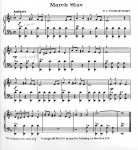Glenn said:
The tell tale signs that it is minor is the augmented 7th, namely you raise the 7th note of the scale one semitone.
Thus in the case of A minor the G becomes a G#.
Theres a good deal of information about this in the wikipedia article
Minor scale. According to their classification, that augmented 7th belongs to the
harmonic minor.
The present example looks like what they call the
Hungarian minor scale, with both 7th and 4th augmented. I was talking to some of my Balkan brass band colleagues about this very same stuff last night, and wish I had read that article beforehand! The piece in question there had been written out with 3 sharps, but turns out to be G minor Hungarian as best as I can make out, which would call for two flats. Either way it wont line up so well with the key signature and there will be frequent accidentals.
The
natural minor is the one thats really the evil twin of the major scale, having all the same notes but just starting in a different place.
One place I think this may show up for accordion players is the III chord; in the key of C, for example, E. Well, really Em, right? because the G third is minor ... but if you were really playing A
harmonic minor, it would be E, does that make sense?

